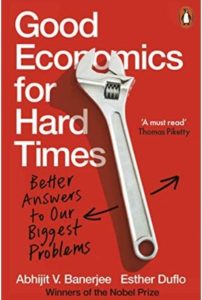Another Fed meeting is looming, and another equity sell-off is taking place. The CPI numbers published on Friday, once again, painted a picture which is very difficult to reconcile with the current setting of monetary policy.
Geopolitics do also matter of course, but let’s not kid ourselves, current inflation numbers have very little to do with Russia’s invasion of Ukraine. Energy and food prices have risen since, but they were well on their way higher before Russian tanks crossed the border, and rather reflect a long-run macro backdrop of resources getting scarcer, not the result of supply disruption caused by sanctions.
Ukrainian resistance has been very fierce and, as this isn’t exactly turning out to be a re-run of Operation Bagration, Russian military progress has been very slow. Because of that, question marks are legitimately being raised about the area’s future capacity to keep Europe and Africa supplied with grains, but the key takeaway here is that while it might matter on the margin, the forces driving this move higher in food prices are global, and much deeper rooted than the conflict in Ukraine. Prices are rising as a direct result of our inability to keep on expanding grain supply globally in the face of climate change. Crop yields have stagnated for more than a decade, and on top of that grains are being put to use in other areas than food production. Biofuel being the typical example.
We might still only be in the early stages of a climate change-driven bear market for stocks and credit, and if so, in that sense it matters little what Powell and the rest of FOMC might decide on doing later this week. Having outstayed their welcome by a handsome margin before even thinking about tightening policy in the face of the biggest inflationary shock the West was facing for a good 50 years, it is now virtually impossible for the Fed to get ahead of the game. Even a 75 bp move on Wednesday will be too little, too late if the intention is to actually try to get ahead of inflation and, more importantly, inflation expectations. To get into a position where the Fed is actually exacting some kind of control of price developments and attempts to acquire leadership of rate expectations, the amount of tightening needed is simply beyond what this FOMC is able to contemplate (hint – using the template of the tightening cycle in ‘94 would not be enough, not by a country mile). This obviously raises the inevitable question of what Powell & co actually can do here. Not much would be my solemn answer.
At the end of the day, they are dealing with a huge credibility issue that even aggressive tightening will find it difficult to address effectively.
First and foremost, the post-Volcker Fed has used transparency as a guiding light for setting policy (which actually is no bad thing), but fallen into a trap of what transparency actually means. The fallacy of allowing transparency to become the equivalent of pre-announcing policy moves was a grave error, is still an error, and will always remain a serious error by any central bank foolish enough to assume it is somehow enhancing their credibility. It is not. Why ? Let me here refer to Jerry Perenchio’s invaluable “Rules of the road” for leaders in any field of business (rule number 8 to be precise) – take options, never give them. Instead of being transparent about what the Fed is looking at when setting policy and allow the market to both scrutinize and analyse the economic data, and importantly retaining optionality regarding the path of rates and size of the balance sheet, the Fed has become the financial equivalent of a lame duck. Transparency means being clear about what the current policy drivers are, not locking yourself into a predetermined path and pre-announcing future decisions. This fallacy has led to serious consequences for the central bank’s ability to retain leadership.
Secondly, even the most important central bank in the world is actually quite limited in its ability to affect a macro cycle of epic proportions that has quietly been unfolding over the last couple of years. I am of course talking about climate change. This is the real macro story that matters at the moment, and while central bank efforts to control prices are not exactly being helped by the emergence of a new, price-insensitive buyer (ie governments in their efforts to reach various net-zero targets) which is putting additional pressure on scarce resources, it would serve them better if they at least attempted to be honest about the current backdrop. Blaming the war, Covid outbreaks, and supply chain problems as the root cause of this situation, is about as credible as the single bullet theory was in the 60s. As long as the world keeps doing what we’ve been doing for a long time while disregarding the true cost of the externalities, and at the same time trying to take a quantum leap into renewable energy, we are going to deplete our precious resources more quickly than any central bank can act to try to cool demand. It’s not that monetary policy has suddenly become ineffective, simply that has always been a somewhat less effective tool when dealing with paradigm shifts in the macro-environment.
To me it is clear that the Fed and other central banks can get ahead of inflation and force it back to whatever nominal target they opted to track in their infinite wisdom, it’s just that the economic fallout from doing so is just not going to be acceptable to the talking heads on the Federal Open Market Committee or others. Because at the end-of-the-day, they are fully aware of what the political response to their so called independence would be. In terms of the economic consequences, I would point the reader in a direction of starting to think about a program of global nationalisation of all major commercial banks, extensive food and energy rationing, and a de-facto permanent state of martial law in an attempt to avoid the worst of the social unrest likely to follow such policies (for film buffs among you, think of some kind of combination of Escape from New York and Mad Max).
So what about markets ? While it is clear that 2022 has been pretty brutal to the 60/40 portfolio, which is down almost 20% in less than 6 months, these are still reasonable levels to unload beta when the market allows you, albeit not quite as great as when “A fed meeting when equities wobble” was published earlier this year. Why ? Because valuations do ultimately matter. With SPX trading at a P/E multiple of almost 20, against a backdrop of 8.6% headline inflation and 6% core, the market is not cheap, possibly not even fairly priced, and bear markets tend to end when they have become cheap. Shiller P/E is hovering around 30, a level normally associated with acute altitude sickness for stocks, so there is no support to be found there either. Looking at dividend yields, cash flows and price-to-book-ratios, the picture is if possible even more bleak…and that’s before we are yet to see brutal downward revisions to 2023/4 earnings estimates.
On days like yesterday when the market really pukes, unlike earlier in the year, it is more difficult to find things to buy, as some of the names which were sold indiscriminately then are actually higher in price now. Here I am talking about resilient, battle-hardened companies who produce genuinely needed goods and services, and are used to operate in a hostile environment. They are typically businesses with robust cash flows, balance sheets containing real assets, not intangibles, capable of paying dividends, and you need to buy them when the market allows you too, because others will. They might not actually end up making you money, but in a hostile environment, devoid of places to hide, they offer you the best protection money can buy.
In a world where financial markets are increasingly being driven by the fact that climate change is here and already affecting us, it is worth remembering that planetary risks cannot be divested, hedged or diversified. Act accordingly.



